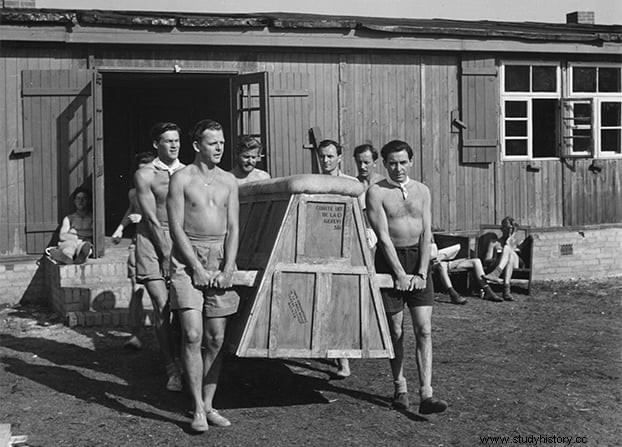One of the most famous moments of World War II is the Great Escape , made popular by the unforgettable 1963 film starring Steve McQueen. The events occurred in March 1944, when three prisoners managed to escape from the German prison camp Stalag Luft III (even though the plan was to get many more out). But what is perhaps not so well known is that there was previously another leak . It is known as the Wooden Horse (The Wooden Horse ).
This first leak occurred in October 1943 and also led to the escape of three of the prisoners . However, on that occasion there was no regrettable loss of life, and the preparation and development of the escape required less effort in terms of material and human resources. However, the procedure was almost as spectacular, since a kind of Trojan horse was used. .
The prisoners involved in the escape plan built a gymnastic horse towards the end of June 1943, using the wood from packages that were regularly sent to them by the Red Cross and the wrappers from cigarette packs. Every day they took the foal out and placed it in the same place, near the perimeter fence of the field, to do gymnastics. Several prisoners spent hours jumping over it while the German guards watched the physical exercises without suspecting a thing.

Not even the size of the wooden rack aroused any doubt in them. Because the fact is that inside the colt, every day a man was hiding, tools and bags, with which he was digging a tunnel in the ground of the field. At the end of the exercise day he collected the tools and the extracted earth was loaded into the bags inside the rack, and was transported back to the interior of the barracks.
As the tunnel lengthened, they had to use bowls attached to ropes to carry the earth up to the mouth and extract it. This slowed down the excavation and made the volunteers who jumped the horse outside end up exhausted. So that the Germans did not discover the tunnel, they placed a board over the hole every day. and covered it with earth. So for three months.
The excavators Taking turns inside the rack were Lieutenants Michael Codner, Eric Williams and Oliver Philpot . Between the three of them they opened a tunnel more than 30 meters long and 76 centimeters deep, using bowls as shovels and metal bars to open ventilation holes. The tunnel was only shored up at its entrance.

By the beginning of October 1943, the tunnel had already passed under the barbed wire of the camp, and the three men began to prepare for the breakout, which was set for the 29th. It had been 114 days since the excavation began.
On the morning of that October 29 the three of them, along with another prisoner named McKay, were carried inside the rack to the mouth of the tunnel in the usual way. Around 6 p.m. the breakout occurred, Codner, Williams and Philpot crawled through the tunnel digging the last section that would take them to the other side of the prison camp perimeter, while McKay was busy sealing the tunnel entrance. /P> 
Once outside they headed to Sagan station, where they caught the first train to Frankfurt and split up there. Philpot made his way to Danzig (today Gdansk) where he managed to hide on a Swedish ship sailing for Stockholm the next day. Codner and Williams stayed together posing as French workers and in the port of Stettin (now Szczecin) they stowed away on a Danish ship that took them to Great Britain.
A film entitled The Wooden Horse was also made from this first escape in 1950, but it would not become as famous as The Great Escape , filmed 13 years later.
Michael Codner, who had been the original brainchild of the Trojan horse idea, was killed in 1952 at the age of 31 in an ambush by communist guerrillas in Malaysia. Oliver Philpot lived to be 80, dying in 1993. Eric Williams became a specialist escape writer (in fact he and Codner had already escaped from Oflag XXIB , but were captured and interned at Stalag Luft III ), dying in 1983.
Williams told the story of the escape in his 1949 book The Wooden Horse.
